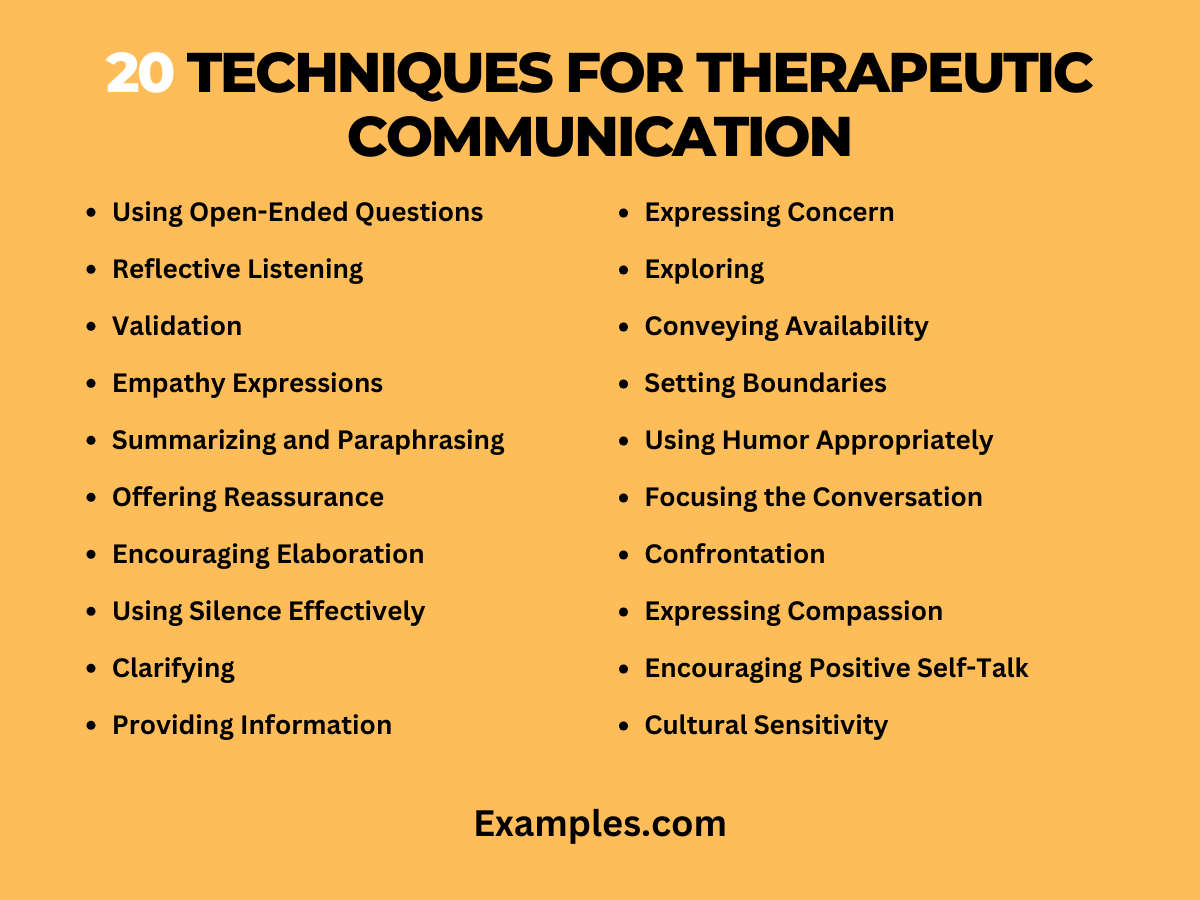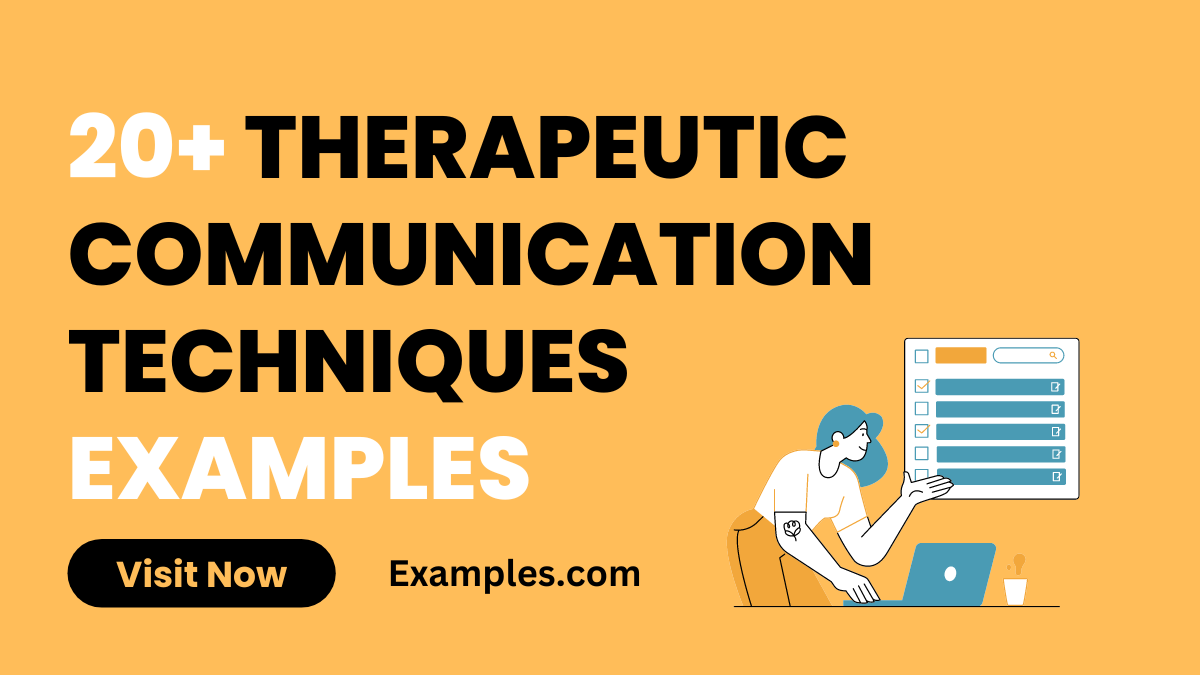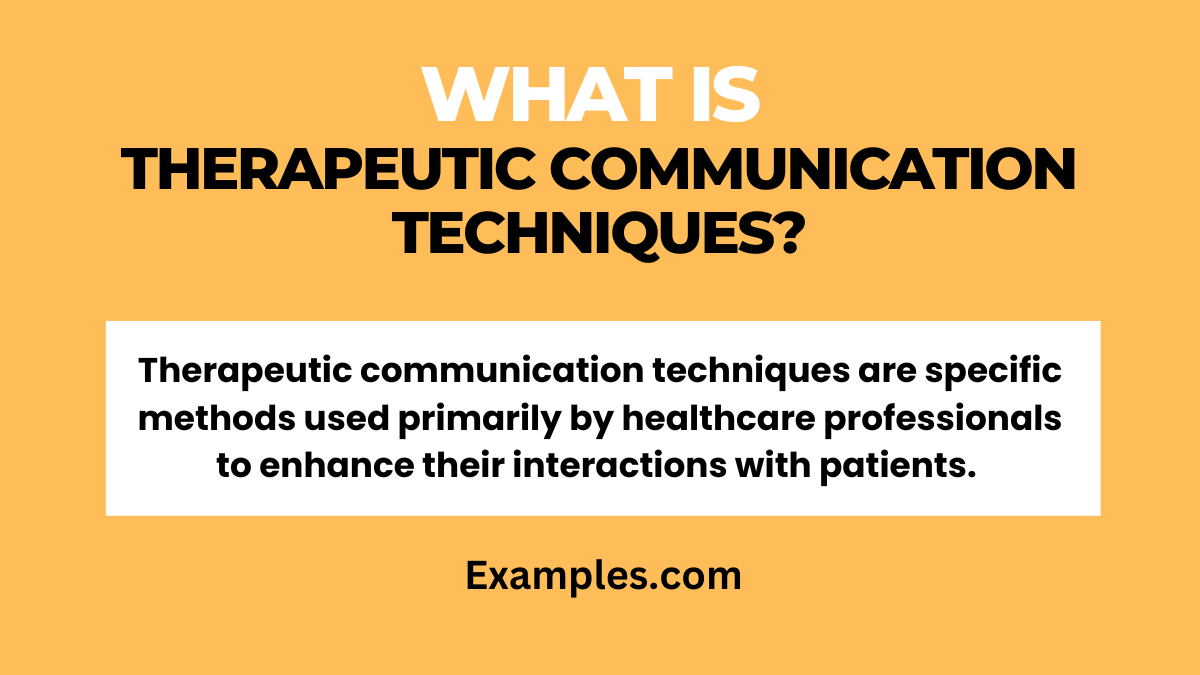19+ Therapeutic Communication Techniques Examples
Welcome to our comprehensive guide on Therapeutic Communication Techniques, a crucial toolset for healthcare professionals. In this guide, we delve into various strategies that enhance patient care through effective communication. From active listening to empathy-driven responses, you’ll learn how to apply these techniques in real-world scenarios. Additionally, we provide practical oral communication examples to illustrate these methods in action, ensuring a deeper understanding of their impact in healthcare settings. This guide is an essential resource for anyone looking to improve their communication skills in a therapeutic context.
What are Therapeutic Communication Techniques?
Therapeutic communication techniques are specific methods used primarily by healthcare professionals to enhance their interactions with patients. These techniques aim to establish a connection, understand patient needs, and provide support. They involve various strategies like active listening, empathy, clear and compassionate verbal exchanges, and nonverbal cues to foster a safe and trusting environment. The goal is to facilitate open dialogue, encourage patient engagement in their care, and support emotional and psychological well-being. These techniques are vital in building a therapeutic relationship that contributes positively to the patient’s overall care and treatment.
20 Techniques for Therapeutic Communication
Discover the art of effective healing conversations with our guide on 20 Techniques for Therapeutic Communication. This resource, offers invaluable insights into the methods that form the backbone of successful therapeutic interactions. Tailored for healthcare professionals, therapists, and counselors, these techniques are essential in building trust, understanding, and progress in therapeutic settings. Each technique is accompanied by a unique example and a brief explanation, demonstrating its application in real-world scenarios. This guide is pivotal for anyone in the therapeutic field looking to enhance their communication skills, fostering deeper connections and facilitating patient healing.
- Using Open-Ended Questions: Encourage patients to share more by asking questions that require more than a yes/no response.
- Reflective Listening: Echo what the patient has said to show understanding and encourage them to continue sharing.
- Validation: Acknowledge the patient’s feelings and experiences, affirming their validity.
- Empathy Expressions: Use phrases that convey understanding and empathy towards the patient’s situation.
- Summarizing and Paraphrasing: Repeat back what the patient has said in your own words to ensure understanding.
- Offering Reassurance: Provide comforting words to alleviate patient anxiety and fear.
- Encouraging Elaboration: Prompt patients to explain their thoughts and feelings in more detail.
- Using Silence Effectively: Allow pauses in the conversation for reflection and processing.
- Clarifying: Ask for more details or clarification to fully understand the patient’s perspective.
- Providing Information: Share relevant information in a clear and understandable manner.
- Expressing Concern: Show genuine concern for the patient’s wellbeing and experiences.
- Exploring: Investigate deeper into the patient’s thoughts and feelings related to their experiences.
- Conveying Availability: Let patients know you are there for them, creating a safe space for open communication.
- Setting Boundaries: Clearly communicate the scope and limits of the therapeutic relationship.
- Using Humor Appropriately: Incorporate humor carefully to lighten the mood, when appropriate.
Therapeutic Communication Techniques for Depression Persons
In the realm of mental health, specifically for individuals with depression, therapeutic communication techniques are crucial. This guide delves into specialized strategies tailored to address the unique needs of those experiencing depression. It emphasizes methods that foster connection, understanding, and empathy, vital for supporting individuals in their journey towards mental wellness. These techniques are designed not only to aid in verbal communication but also to enhance non-verbal interactions, providing a holistic approach to patient care in depression management.

- Validating Emotional Experiences: Acknowledge and validate the emotional experiences of a person with depression, showing understanding and empathy.
- Encouraging Expressive Therapy: Promote expressive forms of therapy, like art or music, to help individuals articulate their feelings non-verbally.
- Building on Small Successes: Focus on small achievements and progress, boosting morale and self-esteem.
- Facilitating Behavioral Activation: Encourage activities and hobbies to increase positive experiences and engagement.
- Mindfulness and Relaxation Techniques: Introduce mindfulness and relaxation exercises to alleviate stress and anxiety.
- Cognitive Reframing: Help in identifying and challenging negative thought patterns and beliefs.
- Supporting Social Connections: Encourage maintaining or developing social connections to combat isolation.
- Empathy in Discussing Medication and Treatment: Discuss medication and treatment options with empathy and understanding.
- Goal Setting and Planning: Collaborate in setting realistic and achievable goals, providing a sense of purpose and direction.
- Reassurance and Hope: Offer reassurance and instill hope, emphasizing recovery and coping possibilities.
Enhancing Patient Care with Therapeutic Communication Techniques
Optimizing patient care involves more than just medical treatment; it requires effective therapeutic communication. This guide provides a comprehensive look at communication techniques that enhance patient care across various healthcare settings. It focuses on strategies that promote understanding, trust, and empathy between healthcare providers and patients. From improving patient compliance to fostering a positive healthcare environment, these techniques are integral to enhancing overall patient satisfaction and outcomes.
- Active Engagement in Patient Concerns: Show genuine interest and concern in the patient’s issues and questions.
- Non-Verbal Empathy: Use body language, such as nodding or leaning in, to express empathy and understanding.
- Patient Education and Explanation: Clearly explain diagnoses and treatments in understandable terms.
- Collaborative Decision Making: Involve patients in decision-making processes regarding their care.
- Cultural Competence: Show sensitivity and understanding towards cultural differences in communication.
- Managing Emotional Responses: Respond to patients’ emotional needs appropriately and compassionately.
- Confidentiality Assurance: Reassure patients about the confidentiality of their information.
- Avoiding Medical Jargon: Use simple language to avoid confusion and ensure understanding.
- Respectful Addressing of Concerns: Address patients’ concerns respectfully and thoughtfully.
- Encouraging Patient Feedback: Invite and value feedback from patients regarding their care experience.




